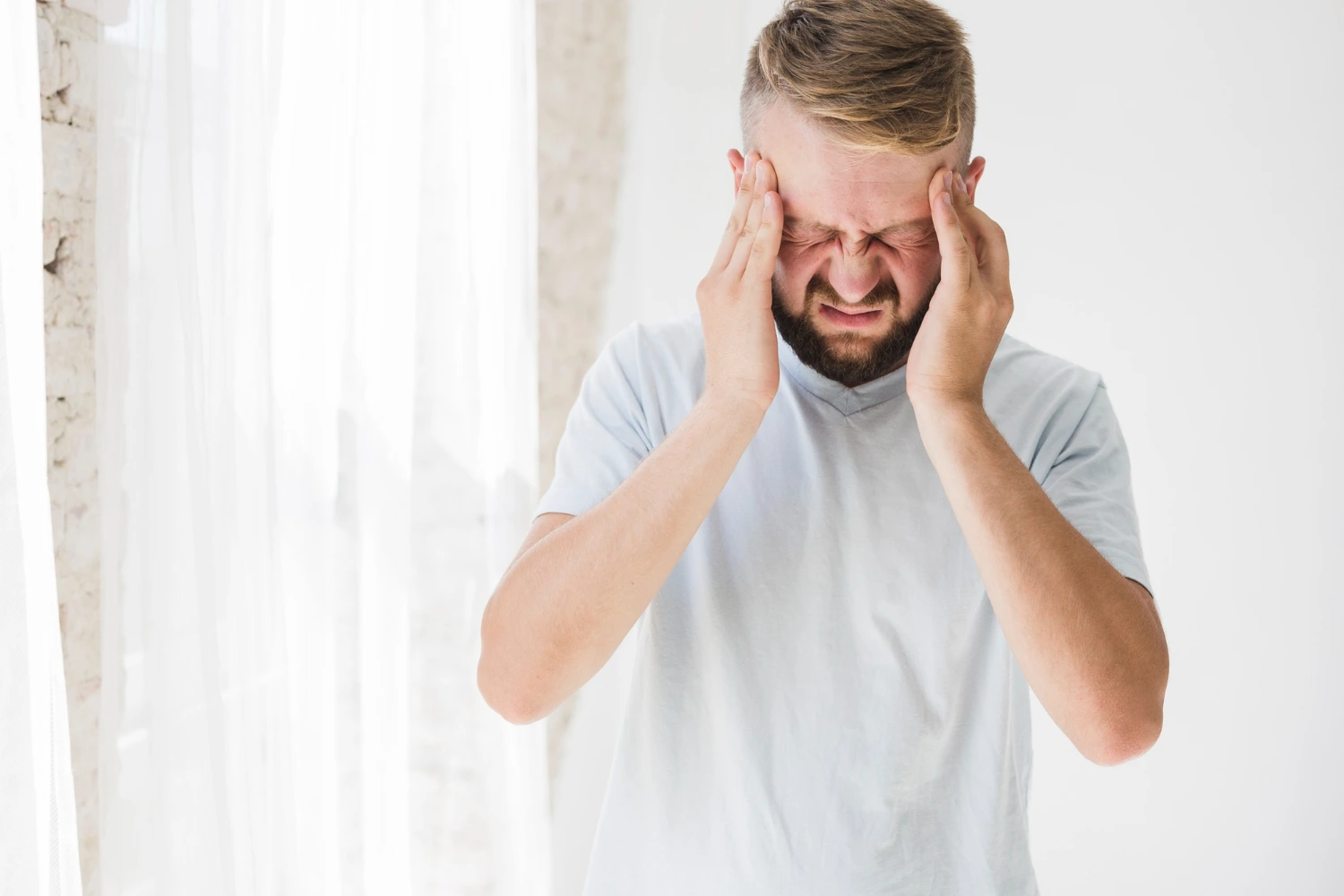According to studies, up to 35% of adults aged 40 and older, which is around 69 million Americans, experience some form of vertigo in their lifetime [1]. In Canada, the prevalence of vertigo is about 30% of the total population [2]. This makes vertigo one of the most common reasons for seeking medical attention for dizziness and balance disorders. Proper diagnosis and treatment are essential, as vertigo symptoms can range from mild to debilitating.
While some vertigo cases resolve on their own, others require targeted therapy, medication, or ongoing management. This guide explains how to diagnose vertigo, explore treatment options, and apply vertigo home remedies.
Vertigo Differential Diagnosis
Proper diagnosis is critical to rule out other conditions that mimic vertigo. Physicians perform a clinical assessment based on symptom patterns, medical history, and physical tests. Here are the most commonly used diagnostic methods:
- MRI (Magnetic Resonance Imaging): Provides detailed images of the brain and inner ear structures to rule out stroke, tumors, or multiple sclerosis.[3]
- CT Scan: A quicker imaging tool to detect bleeding, stroke, or skull injuries that may contribute to central vertigo.[3]
- Audiometry: Hearing tests are used to diagnose conditions like Meniere’s disease that affect both hearing and balance.
- Electronystagmography (ENG)[4] or Videonystagmography (VNG)[5]: Records involuntary eye movements to assess balance and vestibular function.
- Vestibular Evoked Myogenic Potentials (VEMP): Measures the inner ear’s response to sound to detect disorders like vestibular neuritis.[6]
- Dix-Hallpike Test: A positional test to trigger symptoms and identify BPPV.[3]
- Ultrasound of Neck Arteries (Carotid Doppler): Helps detect vascular issues contributing to vertigo in older patients.
These tests are often used in combination to distinguish between peripheral and central causes of vertigo.
Vertigo Test at Home
Although not a substitute for clinical diagnostics, some at-home vertigo tests can help indicate balance issues:
- Romberg Test: Stand with feet together and eyes closed. Swaying or loss of balance may suggest vestibular dysfunction.[7]
- One-Leg Balance Test: Stand on one leg with eyes closed. Difficulty holding balance may indicate coordination issues.[8]
While these tests can offer clues, consult a vertigo specialist for a proper diagnosis and treatment plan.
What Is the HINTS Test for Vertigo?
HINTS (Head-Impulse, Nystagmus, Test of Skew) is a bedside exam to distinguish peripheral from central vertigo. It’s typically performed in emergency settings. Accurate interpretation requires clinical training but plays a key role in identifying stroke-related vertigo.[9]
When Is Vertigo an Emergency?
Seek immediate care if vertigo is accompanied by double vision, difficulty speaking, weakness, or fainting. These signs may indicate stroke or neurological emergencies. If symptoms appear suddenly and severely, call emergency services.
H3 Can Vertigo Go Away on Its Own?
Yes, certain types like BPPV may resolve spontaneously. However, if vertigo persists, worsens, or recurs frequently, medical evaluation is essential. Chronic cases often require a structured vertigo treatment plan.
Vertigo Treatment Options
Vertigo treatment depends on the underlying cause. Effective care may include maneuvers, medications, lifestyle changes, or even surgery in advanced cases. The primary goal is to reduce symptoms, restore balance, and prevent recurrence.
Moore MyoWorx Vertigo Treatment
Moore MyoWorx uses an integrative neuromuscular approach to vertigo treatment. Their protocol combines manual therapy, supervised vestibular exercises, and neurofunctional retraining.
A key component is the TM20 device, which delivers targeted electrical stimulation to deep neck muscles. This stimulation helps improve blood flow and relieve tension, especially for patients with post-concussion syndrome or cervicogenic vertigo.
Combined with individualized physical exercises and clinical oversight, Moore MyoWorx therapy improves neuromuscular coordination, restores cervical function, and enhances sensory integration for long-term vertigo relief.
Vertigo Treatment Medication (Including OTC)
Vertigo treatment medication varies depending on the cause and severity of symptoms. Over-the-counter and prescription options include:
- Meclizine (Antivert): An antihistamine used to reduce nausea, dizziness, and motion sensitivity.[10]
- Dimenhydrinate (Dramamine): Another OTC antihistamine for short-term symptom relief.[10]
- Diazepam (Valium): A benzodiazepine used in severe cases to calm the vestibular system (short-term use only).[10]
- Ondansetron (Zofran): An anti-nausea medication often prescribed during intense vertigo episodes.[11]
- Betahistine (Serc): Common medication for vertigo in Canada, used for Meniere’s disease.[12]
Vertigo medication should always be taken under a doctor’s supervision and is often short-term.
Vertigo Surgery
Surgery is a last resort for chronic, unresponsive vertigo. Procedures like endolymphatic subarachnoid shunt or vestibular nerve section may be considered for Meniere’s disease or tumors. These are rare but effective when other treatments fail.[13]
Alternative and Complementary Treatments
Some patients find relief through vestibular rehabilitation therapy (VRT), acupuncture, chiropractic care, or herbal supplements. These approaches can complement standard treatment but should always be supervised by a healthcare provider.
How to Treat Vertigo After Head Injury?
Start by ruling out serious issues like brain injury or bleeding. Once cleared, treatment may include vestibular rehab, neck therapy, vertigo medicine, and at-home balance exercises. A specialist can guide a recovery plan tailored to your needs.
Vertigo Treatment at Home
Home-based vertigo remedies focus on managing symptoms naturally and promoting balance recovery. While not a cure, these methods support daily wellness.
Vitamins, Supplements, and Diet for Vertigo R
Certain nutrients may help reduce vertigo frequency and severity:
- Vitamin D: Deficiency is linked to BPPV. Supplementation may reduce recurrences.[14]
- Magnesium: Helps with migraine-related vertigo and neurological function.[15]
- Vitamin B12: Supports nerve health and reduces dizziness linked to neuropathy.
- Ginger: Used as a vertigo natural remedy and an anti-nausea agent, often taken in capsules or as a tea.
- Ginkgo Biloba: May improve circulation to the inner ear and brain.
- Hydration: Dehydration can trigger vertigo—drink plenty of fluids daily.[14]
A diet rich in leafy greens, lean proteins, whole grains, and anti-inflammatory foods supports overall vestibular health. Limit salt and caffeine for Meniere’s disease management.
What Am I Lacking If I Have Vertigo?
Low Vitamin D levels have been linked to BPPV. Iron and magnesium deficiencies may also contribute to dizziness. A blood test can identify gaps, and a nutritionist can advise on a targeted plan.
Vertigo Maneuver at Home
Repositioning maneuvers are first-line vertigo treatments for BPPV. These include:
- Epley Maneuver: Moves displaced crystals (otoconia) in the inner ear back to their correct chamber. Follow a step-by-step guide or perform under professional supervision.
- Semont Maneuver: A rapid head movement technique useful for posterior canal BPPV.
- Brandt-Daroff Exercises: Repeated head movements done at home to help desensitize the vestibular system over time.[16]
Consistency and correct form are key. Always consult a healthcare provider before attempting at-home maneuvers.
Vertigo Exercises and Balance Training
Vestibular rehabilitation therapy (VRT) includes exercises that retrain the brain to interpret balance signals accurately. At-home options include:
- Gaze Stabilization (VOR x1 and x2): Focus on a fixed target while moving the head side-to-side or up-and-down.
- Balance Training: Use foam pads or balance boards to challenge the vestibular system in a safe, controlled setting.
- Head Movement Exercises: Gradually increase head turns while walking to reduce motion sensitivity.
These vertigo exercises build tolerance to movement, improve stability, and support long-term recovery.
What Will Happen If Vertigo Is Left Untreated?
Untreated vertigo can impair quality of life, cause anxiety, and increase fall risk. Chronic dizziness may also mask more serious neurological issues.
What Triggers Vertigo Attacks
Various internal and external factors can initiate or worsen symptoms. Recognizing your personal triggers can help guide your vertigo treatment plan and improve your quality of life.
In general, triggers depend on the underlying condition but may include:
- Sudden Head Movements: Often worsen BPPV symptoms.
- Dehydration: Reduces blood volume and inner ear function.
- Anxiety and Stress: Can disrupt vestibular signals and amplify symptoms.
- Visual Overload: Bright lights or screen time may trigger episodes in those with vestibular migraine.
- Poor Sleep or Skipping Meals: Fluctuating blood pressure or sugar can also provoke dizziness.[14]
Keeping a symptom diary helps identify personal triggers and tailor your vertigo cure plan.
What Not to Do When You Have Vertigo
Avoid rapid head turns, alcohol, and screen overuse. Don’t drive or operate machinery during an episode. Staying still in a safe position reduces the risk of falls.
Should You Stay in Bed with Vertigo?
In acute phases, rest is helpful. However, prolonged inactivity can delay recovery. Gradual movement and therapeutic exercises promote better long-term outcomes.
How to Prevent Vertigo
Preventative strategies include staying hydrated, avoiding known triggers, and maintaining a consistent sleep routine. Managing chronic conditions like migraines or anxiety also reduces flare-ups.
Vestibular exercises performed regularly may lower recurrence risk in BPPV.
Vertigo Relief: Your Action Plan Moving Forward
From physical maneuvers and medication to dietary changes and exercise, multiple strategies may be needed for lasting relief. Consulting a vertigo clinic ensures a personalized plan, especially for those with complex symptoms. Long-term improvement depends on patient education, lifestyle modifications, and consistent follow-up.
If symptoms persist or worsen, seek help from a certified vertigo specialist for comprehensive evaluation and guidance. For a targeted and integrative approach, contact Moore MyoWorx.
References
- Veda: “About Vestibular Disorders”.
- Odyo: “Vertigo”.
- Teach Me Surgery: “Vertigo”.
- Johns Hopkins Medicine: “Electronystagmography (ENG)”.
- Medicine plus: “Videonystagmography (VNG)”.
- National Library of Medicine: “Clinical significance of vestibular evoked myogenic potentials in benign paroxysmal positional vertigo”.
- Physiopedia: “Romberg Test”.
- MAT: “Balance and Proprioception: Single-Leg Balance – Eyes Closed”.
- Physiopedia: “HINTS Exam”.
- AAFP: “Treatment of Vertigo”.
- National Library of Medicine: “Ondansetron or promethazine: Which one is better for the treatment of acute peripheral vertigo?”.
- Canadian Pharmacy King: “Serc (Betahistine)”.
- National Library of Medicine: “Surgery for vertigo (you don’t have to live with it)”.
- Brain and Spine Chiropractic: “10 Drug-Free Ways to Stop Vertigo”.
- Dizzy and Vertigo: “7 Types of Magnesium Supplements for Vestibular Migraine”.
- WebMD: “Home Remedies for Vertigo”.




